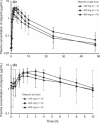A Phase I, dose-finding and pharmacokinetic study of olaparib (AZD2281) in Japanese patients with advanced solid tumors
- PMID: 22145984
- PMCID: PMC7713608
- DOI: 10.1111/j.1349-7006.2011.02179.x
A Phase I, dose-finding and pharmacokinetic study of olaparib (AZD2281) in Japanese patients with advanced solid tumors
Abstract
Olaparib (AZD2281) is an orally active Poly(ADP-ribose) polymerase (PARP) inhibitor with favorable antitumor activity in advanced ovarian and breast cancers with BRCA1/2 mutations in Western (USA and European) studies. This Phase I dose-finding study evaluated the tolerability, pharmacokinetics, PARP inhibitory activity, and antitumor activity of olaparib in Japanese patients with solid tumors. Olaparib was administered as a single-dose on day 1, followed by twice-daily dosing for 28 days from 48 h after a single dose. Doses were escalated from 100 mg b.i.d. in successive cohorts, up to a maximum of 400 mg b.i.d. The present study enrolled 12 patients (n = 3, 3, and 6 in 100, 200 and 400-mg b.i.d. levels, respectively). The most common adverse events were nausea, increased blood creatinine, decreased hematocrit, leukopenia and lymphopenia; dose-limiting toxicities were not observed up to and including the 400-mg b.i.d. dose level. Following twice-daily dosing, olaparib showed no marked increase in exposure at steady state over that expected from the single-dose pharmacokinetics. PARP-1 inhibition was observed from the 100-mg b.i.d. dose level in peripheral blood mononuclear cells from 6 h post-dose on day 1 during the multiple-dosing period. A patient with metastatic breast cancer (100 mg b.i.d.) had a partial response for 13 months and four patients (two each in the 200 and 400-mg b.i.d. levels) had stable disease >8 weeks. Olaparib was well tolerated up to the 400-mg b.i.d. dose in Japanese patients with solid tumors. Preliminary evidence of antitumor activity was observed.
Trial registration: ClinicalTrials.gov NCT00572364.
© 2011 Japanese Cancer Association.
Figures
References
-
- Amé J‐C, Spenlehauer C, de Murcia G. The PARP superfamily. Bioessays 2004; 26: 882–93. - PubMed
-
- Gudmundsdottir K, Ashworth A. The roles of BRCA1 and BRCA2 and associated proteins in the maintenance of genomic stability. Oncogene 2006; 25: 5864–74. - PubMed
-
- Ashworth A. A synthetic lethal therapeutic approach: Poly(ADP) ribose polymerase inhibitors for the treatment of cancers deficient in DNA double‐strand break repair. J Clin Oncol 2008; 26: 3785–90. - PubMed
-
- Bryant HE, Schultz N, Thomas HD et al. Specific killing of BRCA2‐deficient tumours with inhibitors of poly(ADP‐ribose) polymerase. Nature 2005; 434: 913–7. - PubMed
-
- Farmer H, McCabe N, Lord CJ et al. Targeting the DNA repair defect in BRCA mutant cells as a therapeutic strategy. Nature 2005; 434: 917–21. - PubMed
Publication types
MeSH terms
Substances
Associated data
LinkOut - more resources
Full Text Sources
Medical
Miscellaneous


